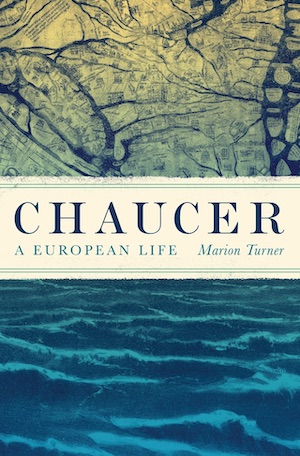By Allen D. Boyer
Chaucer: A European Life is a masterful appreciation of the first great poet of the living English language—a biography of Geoffrey Chaucer wrapped around a thoughtful study of what Chaucer wrote and what he read. The title recalls the recent furor over Brexit, but the book is not an artifact of that struggle. It is a study of a poet who took from France and Italy (and farther realms, the classical world and medieval Araby) subjects and forms and techniques that he brought to his own language.
In Geoffrey Chaucer’s day, Marion Turner writes, “England, like other nations, was and is a process, always becoming something that it was not before.” She continues: “To be an educated Englishperson at this time demanded an international outlook; the court (like the city of London) was full of people of varying nationalities, the fashionable literary texts were mainly written in French, the queen and her ladies brought Hainault culture to the forefront.”
In focusing on Chaucer’s continental connections, Turner highlights many details of the poet’s English career. In Vintry Ward, the London neighborhood where Chaucer was born, Flemish newcomers would be massacred during the Peasants’ Revolt of 1381. When the young Chaucer was camped with the English army outside Reims, one of the city’s defenders was Guillaume de Machaut, the French poet from whom Chaucer would learn much about irreverence and unreliable narrators. Chaucer’s wife, Philippa, was the daughter of a knight from Hainault, employed in the household of John of Gaunt (for Ghent)—an English king’s son born across the Channel, with a Hainuyer count’s daughter for his mother and two French princesses for grandmothers.
The tales-within-a-tale structure of Chaucer’s greatest work rhymes resonantly with the murals of Giotto (which Chaucer would have seen on his visit to Florence in 1373), series of tableaux in which each scene is shown from a single human perspective. The age’s dawning interest in cosmography seems to lie behind two of Chaucer’s other books: A Treatise on the Astrolabe, which he compiled for his young son Lewis, and The House of Fame, in which he imagined looking down on the earth from the talons of a giant eagle.
Turner unpacks the culture within which Chaucer worked. The Tower of London appears as a dubious symbol, a fortress and arsenal, a place where coins were minted from bright gold and sumptuous processions staged—a death-trap, too, when the London mob broke down the doors. The Tabard Inn of Southwark is a “mixed space,” part ale-house, part refuge, part performance space. But sometimes what seems metaphorical is actually quite down-to-earth. In a chapter titled “Cage,” Turner examines not only the convent which Chaucer’s daughter entered, but also a set of actual birdcages. As clerk of the king’s works, Chaucer oversaw the royal falcons in their mews.
In his role as a servant of the crown, Chaucer spent his life based in London and in Kent. A short stint overseeing a royal forest may have taken him west to Somerset. As a writer, he ranged more broadly: across Oxfordshire, East Anglia, the Yorkshire coast marshes of Holderness, as far north as Northumbria. “Chaucer is interested in the power and energies of these rural societies—the North is not a strange other-land to him,” Turner concludes.
After six centuries, the personalities of The Canterbury Tales remain vivid. Chaucer may have borrowed the stories that they tell, but these pilgrims are his own creation. A strength of this book is that Turner looks beyond the portraits that Chaucer so emphatically sketched to emphasize the vitality with which he imbued his characters. It is their unruliness, their reactions and interaction, that gives a collection of tales its shape.
“The project of ‘The Tales’ involves a leveling of discourse akin to a leveling out of power,” Turner concludes. “The meaning of ‘The Knight’s Tale’ is constructed through ‘The Miller’s,’ ‘Reeve’s,’ and ‘Cook’s’ Tales—and indeed through ‘The Wife of Bath’s Tale,’ the ‘Tale of Sir Thopas,’ and the ‘Squire’s Tale’ . . . . Chaucer’s use of the tale-collection genre allows him to demonstrate that one perspective cannot be the whole story; the reader needs to hear multiple perspectives to put together a picture.”
The genius of the book “lies in its valuing of difference qua difference, and its refusal either to collapse those differences or to prioritize saint’s life over folktale, man over woman, knight over miller, marquis over peasant girl, moral truth over poetic line, idea over rhetoric.”
Despite his international connections, Chaucer knew his native land, and to its people he accorded a full measure of grace.
Allen D. Boyer (ΦBK, Vanderbilt University), a lawyer and writer in New York City, is the author of Sir Edward Coke and the Elizabethan Age. He is currently at work on a history of the law of treason in England. Vanderbilt University is home to the Alpha of Tennessee Chapter of Phi Beta Kappa.




